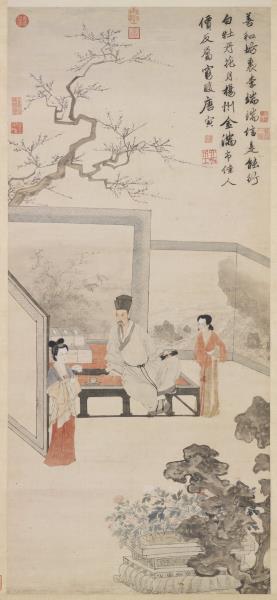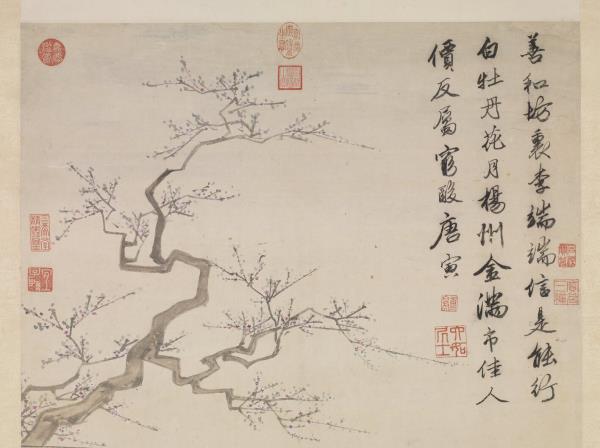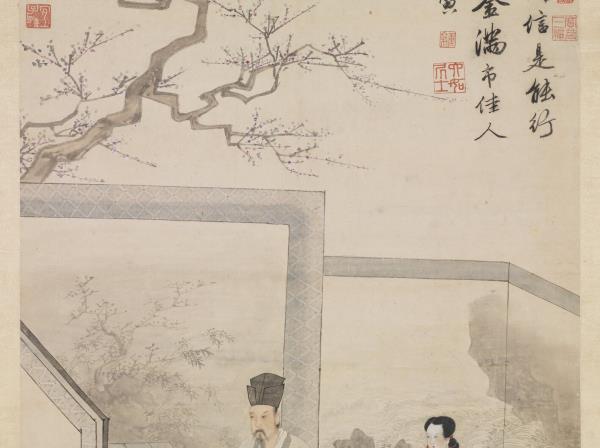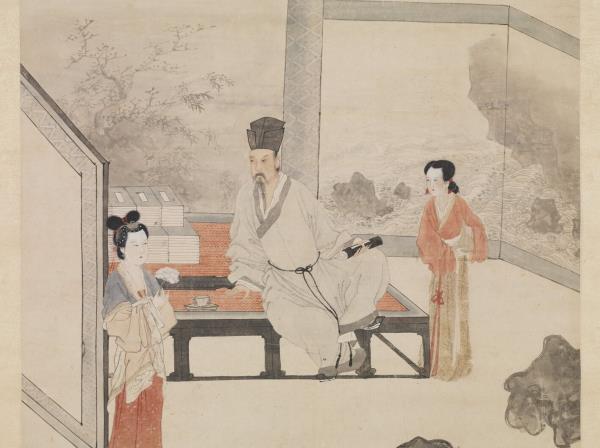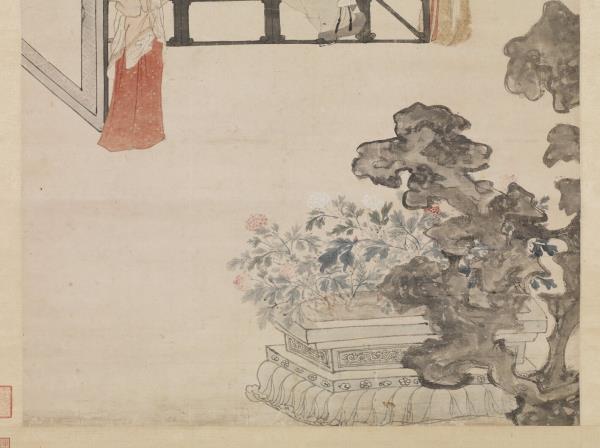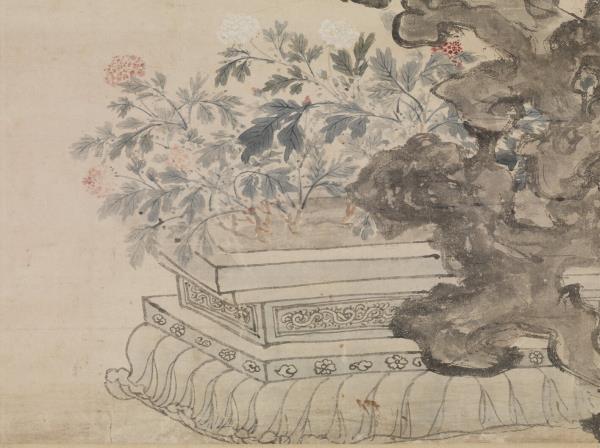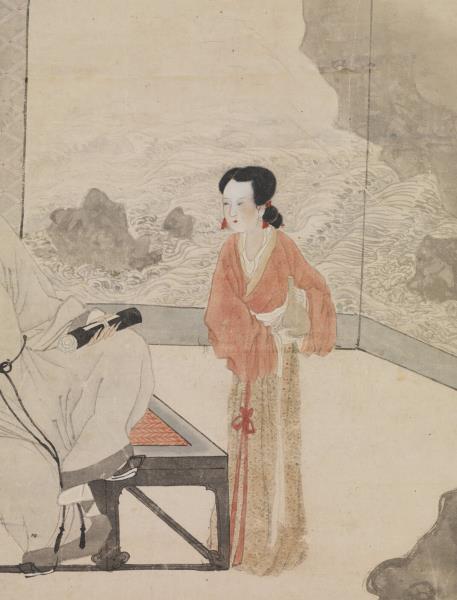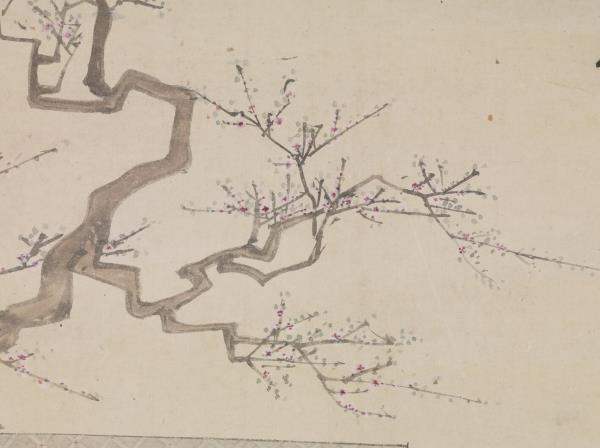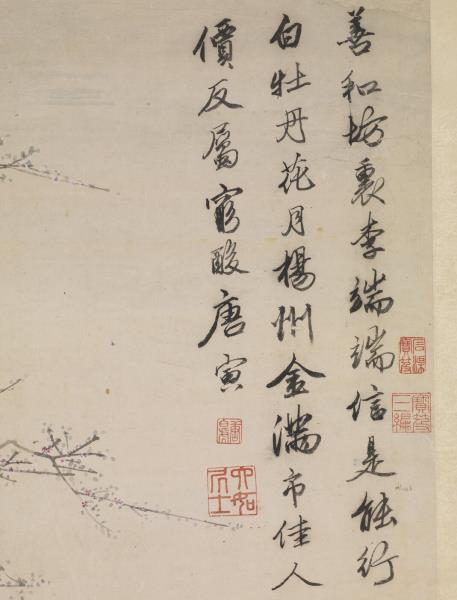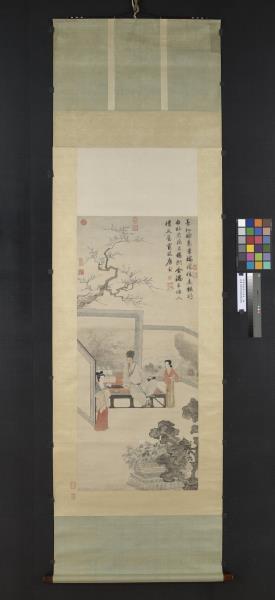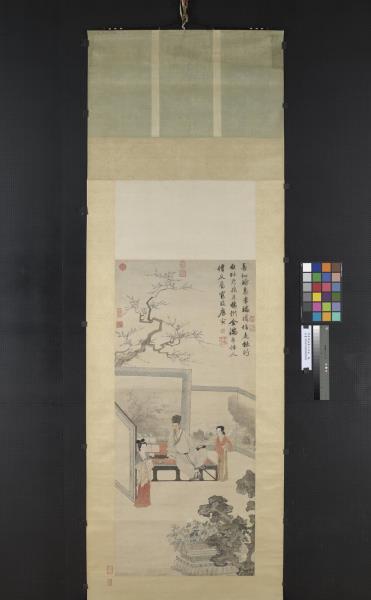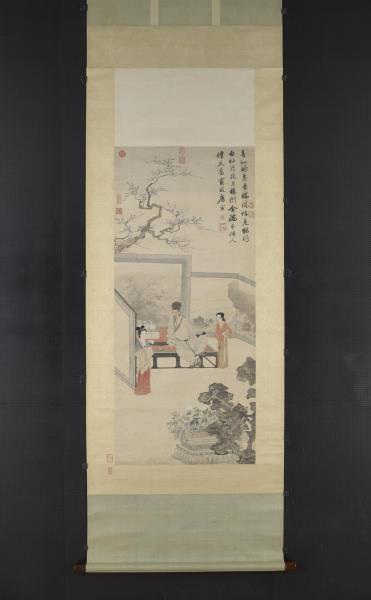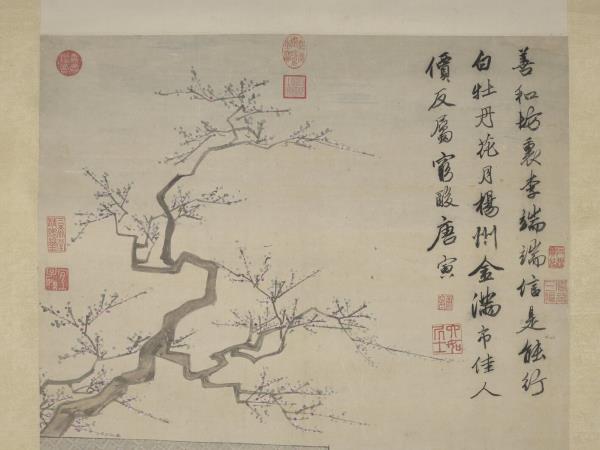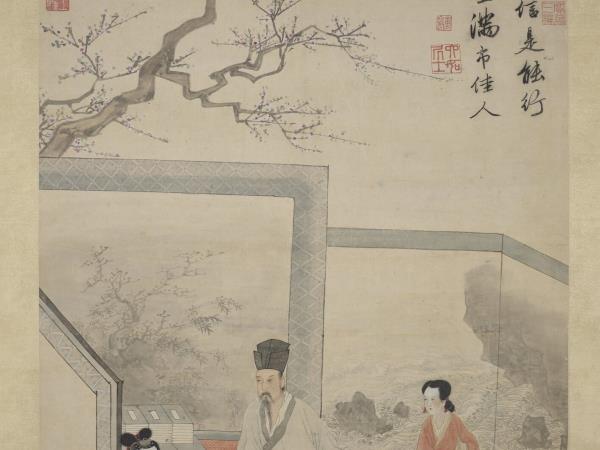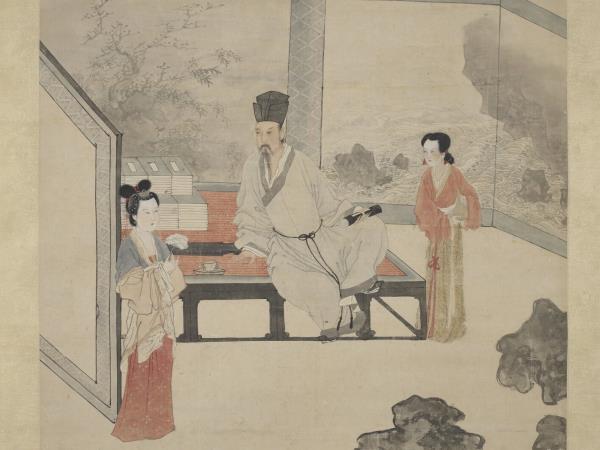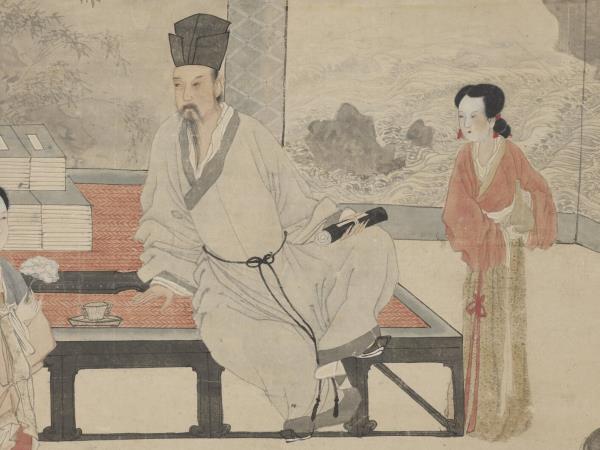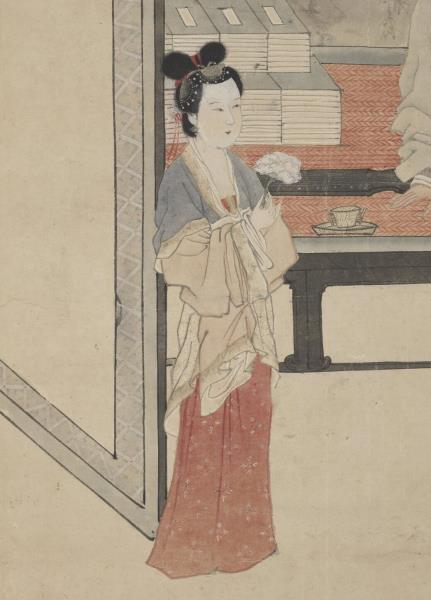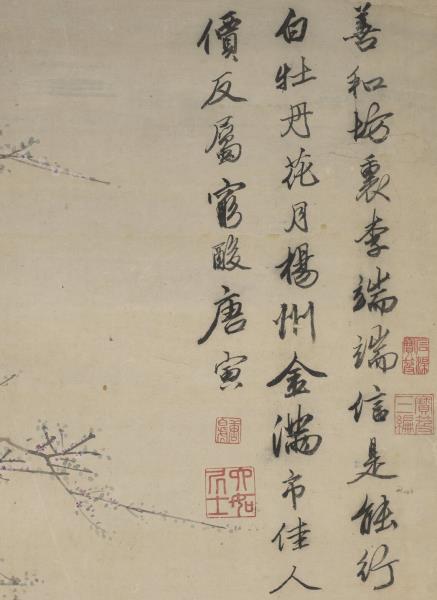| 文物統一編號 |
故畫000475N000000000
|
| 作品號 |
故畫00047500000 |
| 品名 |
明唐寅倣唐人仕女 軸
After a Tang Painting of a Courtesan |
| 分類 |
繪畫 |
| 作者 |
唐寅 |
| 數量 |
一軸 |
| 題跋類別 |
作者 |
位置 |
款識 |
書體 |
全文 |
| 作者款識 |
唐寅
印記 expand_more
|
本幅 |
善和坊裡李端端。信是能行白牡丹。花月揚州金滿市。佳人價反屬窮酸。唐寅。 |
行書 |
|
|
|
| 印記類別 |
印主 |
印記 |
| 鑑藏寶璽 |
清內府印 |
三希堂精鑑璽 |
| 鑑藏寶璽 |
清內府印 |
石渠寶笈 |
| 鑑藏寶璽 |
清內府印 |
宜子孫 |
| 鑑藏寶璽 |
宣統帝 |
宣統御覽之寶 |
| 鑑藏寶璽 |
清仁宗 |
嘉慶御覽之寶 |
| 鑑藏寶璽 |
清仁宗 |
嘉慶鑑賞 |
| 鑑藏寶璽 |
清仁宗 |
寶笈三編 |
| 主題類別 |
主題(第一層) |
主題(第二層) |
主題說明 |
| 主要主題 |
人物 |
仕女 |
|
| 主要主題 |
人物 |
高士(士人、隱士) |
|
| 主要主題 |
經史‧故事 |
|
唐李瑞瑞與吳楚狂士崔涯(或張祐)
|
| 主要主題 |
器用 |
服飾(對人) |
|
| 主要主題 |
器用 |
傢俱(屏風) |
榻、屏風 |
| 次要主題 |
人物 |
侍從(侍女、童僕) |
侍女 |
| 次要主題 |
山水 |
奇石 |
|
| 次要主題 |
花草 |
牡丹 |
|
| 次要主題 |
花草 |
桃花 |
|
| 次要主題 |
器用 |
文玩(琴棋書畫) |
膽瓶、花台 |
| 次要主題 |
器用 |
花器 |
|
| 次要主題 |
器用 |
飲食器 |
|
| 次要主題 |
器用 |
樂器 |
琴 |
| 次要主題 |
樹木 |
竹 |
|
| 次要主題 |
樹木 |
寒林.枯樹 |
枯樹 |
| 技法 |
技法細目 |
| 人物衣紋描法(勻稱線條) |
|
| 人物衣紋描法(粗細線條) |
|
| 工筆 |
|
| 沒骨 |
|
| 界畫 |
|
| 皴法 |
卷雲皴 |
| 皴法 |
斧劈皴 |
| 寫意 |
|
| 類別 |
參考資料 |
| 內容簡介 |
唐寅(1470-1523)是吳縣人(今江蘇蘇州)。年少時,即以文采名聞鄉里,弘治十一年(1498),復高中南京鄉試第一名解元。他作畫起初師法周臣(約1460-1535後),後又廣學宋、元名家,能將南宋院體畫精謹秀麗的畫法,與元人清雋淡雅的筆墨融為一爐,而形成自家面貌,以致被後人尊為「明四大家」之一。本幅題材,取自唐代名妓李端端向崔涯乞詩的故事。畫中的李端端,手持一朵白牡丹,亭亭玉立於屏風前方。崔涯則坐在榻上,神情相當專注,彷彿正要為美人構思佳句。崔涯有詩贈李端端,詩中「一朵能行白牡丹」之句,對照此圖中的仕女,極稱契合。 幅中人物及屏風,落筆俱極工緻,惟配景樹石及款書部分,線條較為縱放,與唐寅四十七歲作的「山路松聲」(1516)相當接近,故推測可能是同年或者稍早的作品。(劉芳如)
|
| 內容簡介 |
本幅題材,取自唐代名妓李端端向崔涯乞詩故實。畫李端端,手持白牡丹,亭亭立於屏風前。崔涯坐榻上,神情專注,彷彿正欲為美人構思佳句。崔涯詩云:「一朵能行白牡丹」,與此圖同看,極稱契合。 幅中人物及屏風,落筆俱工緻,惟配景樹石及款書部分,線條較為縱放,與「山路松聲」(1516)接近,推測可能為同年或稍早的作品,時唐寅約四十七歲。
|
| 內容簡介 |
唐寅(西元1470-1523年),吳人(今江蘇蘇州)。字子畏,一字伯虎,號六如。賦性疏朗,狂逸不羈。弘治戊午舉南京解元,畫師周臣而遠過之。為明四大家之一。唐崔崖、張祐,均以詩名揚州。每題詩娼肆,受其譽者則車馬盈門。妓女李端端往求之,獲一詩,有「揚州近日無雙價,一朵能行白牡丹」之句,於是賓客咸臻其門。此圖殆即繪李端端往崔崖,或張祐處乞書故事。
|
| 內容簡介 |
唐寅(西元1470-1523年),字伯虎,吳縣人(今江蘇蘇州)。弘治戊午年得中南京解元,作畫初受杜菫、周臣影響,後又廣學宋、元名家,形成自家面貌,被後人尊為明四大家之一。本幅題材,取自唐代名妓李端端向崔涯乞詩的故事。畫中美人,手持白牡丹,亭亭立於屏風前。崔涯坐榻上,神情專注,彷彿正要為她構思佳句。崔涯詩中有「一朵能行白牡丹」之句,恰似此圖的寫照。(20100101)
|
| Description |
Tang Yin (style name Bohu), a native of Wuxian (modern Suzhou, Jiangsu), came in first place at the Nanjing provincial examinations in 1498. His early style was influenced by the Ming painters Du Jin and Zhou Chen, but later he studied the styles of many earlier Song and Yuan masters to form his own manner, leading him to be venerated as one of the Four Ming Masters. The subject of this lady painting comes from the story of the courtesan Li Duanduan seeking a lyric from the poet Zhang You (?-ca. 853). In it, Li Duanduan is shown holding a white peony blossom and standing upright by a screen. Zhang You sits on a daybed and concentrates, as if composing the line that made Li famous, “…a peony blossom able to walk along.” The line and image here thus seem to match flawlessly.(20100101)
|
| Description |
T’ang Yin, style name Po-hu, was a native of Soochow Kiangsu. He studied painting under Chou Ch’en but eventually surpassed him in skill and fame. T’ang Yin was also noted for his poetry and calligraphy, and he is counted as one of the Four Masters of the Ming dynasty. Two noted T’ang poets, Ts’ui Ya and Chang Yu, wrote poems about the boudoirs of the demimonde. Customers flocked to the establishments they praised, while the houses they criticized were deserted. A certain courtesan by the name of Li Tuan-tuan entreated for and obtained a poem by one of them, in which she was lauded: “Yangchow was recently startled to see a white peony that could walk.” Thereafter she became much sought after. This painting depicts the episode of Li Tuan-tuan making her request to one of the poets.
|
| Description |
The subject of this work derives from the story of the courtesan Li Tuan-tuan seeking a lyric from the poet Chang Yu. Li Tuan-tuan is shown holding a white peony blossom and standing by a screen. Chang Yu sits on a day-bed and concentrates, as if composing the line that made Li famous; “…a peony blossom who walks along.” The line and image here thus seem to match flawlessly. The brushwork of the figures and screen here is very refined, appearing unrestrained only in the trees and rocks of the background and the inscription in the upper right. Similar to Sound of Pines on a Mountain Path (1516), this work may have been done at around the same time or a little earlier, when T’ang Yin was 46.
|
| 收藏著錄 |
石渠寶笈三編(延春閣),第四冊,頁1865
|
| 收藏著錄 |
故宮書畫錄(卷五),第三冊,頁350
|
| 收藏著錄 |
故宮書畫圖錄,第七冊,頁17-18
|
| 參考書目 |
1.劉芳如,〈明唐寅仿唐人仕女〉,收入國立故宮博物院編輯委員會編,《明中葉人物畫四家特展-杜菫、周臣、唐寅、仇英》(臺北:國立故宮博物院,2000年初版),頁153-154。
2.江兆申,〈唐寅倣唐人仕女 軸〉,收入國立故宮博物院編,《吳派畫九十年展》(臺北:國立故宮博物院,1975年初版,1976年再版,1981年三版),頁293。
3.馮幼衡,〈唐寅仕女畫的類型與意涵 — 江南第一風流才子的曠古沉哀〉,《故宮學術季刊》,第二十二卷第三期(2005年春),頁55-90。
|
| 參考書目 |
林莉娜,〈明唐寅倣唐人仕女 軸〉,收入林莉娜主編《百卉清供-瓶花與盆景畫特展》(臺北:國立故宮博物院,2018.10),頁124-127。
|
| 參考書目 |
鄭淑方,〈明唐寅倣唐人仕女 軸〉,收入劉芳如主編《她-女性形象與才藝》(臺北:國立故宮博物院,2020.10),頁92-93、259。
|
| 參考書目 |
林莉娜、陳建志、鄭淑方,〈明唐寅倣唐人仕女 軸〉,收入《明四大家特展-唐寅》(臺北:國立故宮博物院,2014.07),頁120-123、302-303。
|
本院文物保存維護依〈國立故宮博物院典藏文物管理作業要點〉及〈國立故宮博物院文物修護業務作業原則〉辦理
抽盤點紀錄
修護紀錄

